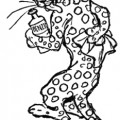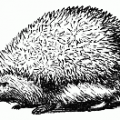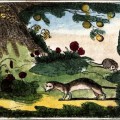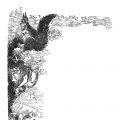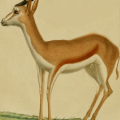Opossums are marsupials that are native to North America. They are primarily a nocturnal animal, coming out at night to hunt for food. They eat fruit, insects and bird eggs. They are also known to scavenge roadkill. But, their favorite food is fruit, particularly apples, clementines, avocados and persimmons. As this vintage opossum drawing shows, they have a fierce-looking set of fifty teeth.
Most people I know call these creatures “possums.” In writing this little piece, I learned that possums are actually a similar marsupial native to Australia, New Guinea and Sulawesi. The most noticeable differences between the two are their coloring and the lovely bushy tail the possums possess.
I also learned that there are around 103 species of opossums found in the Western Hemisphere – the largest are about the size of a large house cat and the smallest can be as small as a field mouse. The biggest misconception many of us have is that their tails are fully prehensile. While they can use their tails almost like a fifth limb when climbing trees, only opossum babies are light enough that their tails can support their full weight.
The opossum will often give birth to more offspring than she has teats to feed them. In what is apparently a bit of survival of the fittest, only those babies able to attach to a teat survive. Some mother opossums can support as many as thirteen offspring.
This opossum drawing shows a mother opossum hanging upside down in a tree branch. We can only see her two front legs and her head. She is literally covered head-to-toe in her offspring. It is a charming black and white animal drawing from 1850. It suffers a bit with some of the details being a bit blurry, as was common in engravings of this type. The book it is from appears to be a small booklet that may have even been self-published. All things considered, this 160+ year old illustration is a wonderful example of these white-faced creatures that are most recognizable by their long, rope-like tails.
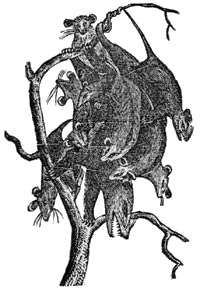
This image is copyright free and in the public domain anywhere that extends copyrights 70 years after death or at least 120 years after publication when the original illustrator is unknown.
